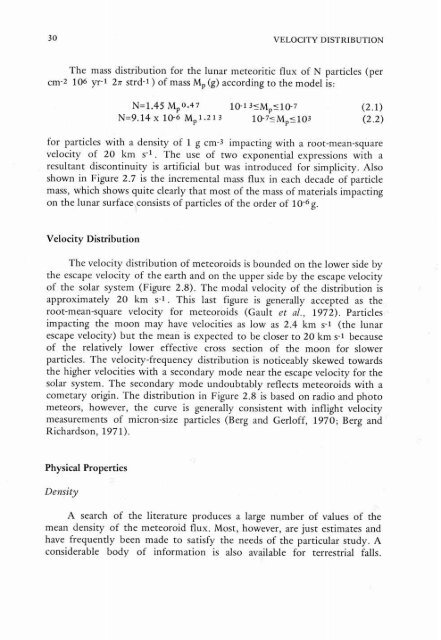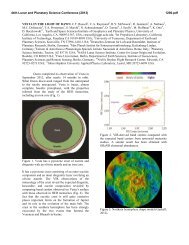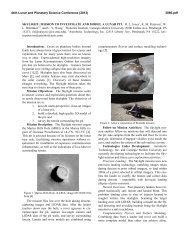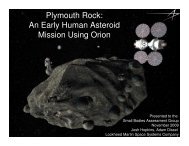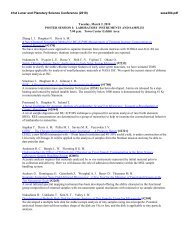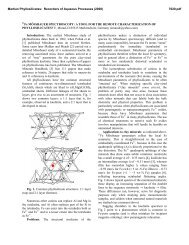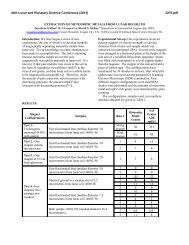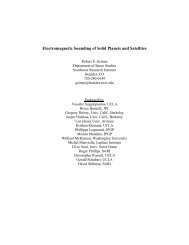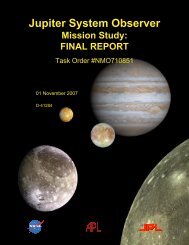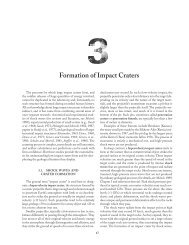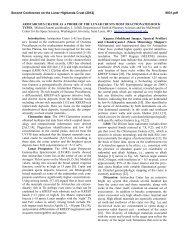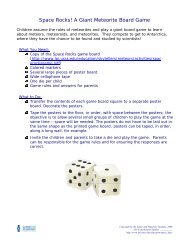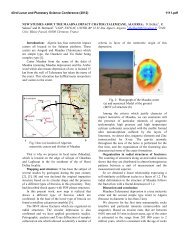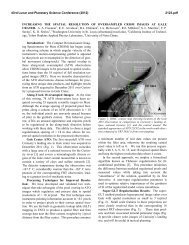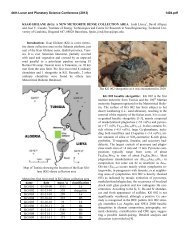Chapter 2: Energy at the Lunar Surface - Lunar and Planetary Institute
Chapter 2: Energy at the Lunar Surface - Lunar and Planetary Institute
Chapter 2: Energy at the Lunar Surface - Lunar and Planetary Institute
You also want an ePaper? Increase the reach of your titles
YUMPU automatically turns print PDFs into web optimized ePapers that Google loves.
VELOCITY DISTRIBUTION<br />
The mass distribution for <strong>the</strong> lunar meteoritic flux of N particles (per<br />
cm-2 106 yr-1 2n strd-1 ) of mass Mp (g) according to <strong>the</strong> model is:<br />
for particles with a density of 1 g cm-3 impacting with a root-mean-square<br />
velocity of 20 km s-l . The use of two exponential expressions with a<br />
resultant discontinuity is artificial but was introduced for simplicity. Also<br />
shown in Figure 2.7 is <strong>the</strong> incremental mass flux in each decade of particle<br />
mass, which shows quite clearly th<strong>at</strong> most of <strong>the</strong> mass of m<strong>at</strong>erials impacting<br />
on <strong>the</strong> lunar surfacqconsists of particles of <strong>the</strong> order of 10-6g.<br />
Velocity Distribution<br />
The velocity distribution of meteoroids is bounded on <strong>the</strong> lower side by<br />
<strong>the</strong> escape velocity of <strong>the</strong> earth <strong>and</strong> on <strong>the</strong> upper side by <strong>the</strong> escape velocity<br />
of <strong>the</strong> solar system (Figure 2.8). The modal velocity of <strong>the</strong> distribution is<br />
approxim<strong>at</strong>ely 20 km s-1. This last figure is generally accepted as <strong>the</strong><br />
root-mean-square velocity for meteoroids (Gault et a[., 1972). Particles<br />
impacting <strong>the</strong> moon may have velocities as low as 2.4 km s-1 (<strong>the</strong> lunar<br />
escape velocity) but <strong>the</strong> mean is expected to be closer to 20 km s-1 because<br />
of <strong>the</strong> rel<strong>at</strong>ively lower effective cross section of <strong>the</strong> moon for slower<br />
particles. The velocity-frequency distribution is noticeably skewed towards<br />
<strong>the</strong> higher velocities with a secondary mode near <strong>the</strong> escape velocity for <strong>the</strong><br />
solar system. The secondary mode undoubtably reflects meteoroids with a<br />
cometary origin. The distribution in Figure 2.8 is based on radio <strong>and</strong> photo<br />
meteors, however, <strong>the</strong> curve is generally consistent with inflight velocity<br />
measurements of micron-size particles (Berg <strong>and</strong> Gerloff, 1970; Berg <strong>and</strong><br />
Richardson, 197 1).<br />
Physical Properties<br />
Density<br />
A search of <strong>the</strong> liter<strong>at</strong>ure produces a large number of values of <strong>the</strong><br />
mean density of <strong>the</strong> meteoroid flux. Most, however, are just estim<strong>at</strong>es <strong>and</strong><br />
have frequently been made to s<strong>at</strong>isfy <strong>the</strong> needs of <strong>the</strong> particular study. A<br />
considerable body of inform<strong>at</strong>ion is also available for terrestrial falls.


